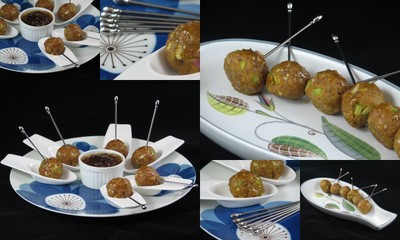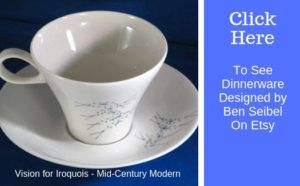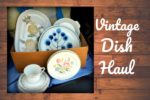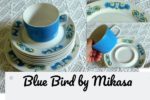Okay, OOAK - one of a kind - might be a bit obscure. But not if you're into vintage dinnerware and china, and love to use those unusual pieces, as well as just looking at them.
It is not necessary to have a complete set of matching tableware to have a great time setting the table or buffet, using your rare, out-of-the-ordinary vintage china.
Thanksgiving, Christmas, Hanukkah or other holidays are an easy excuse to bring out those cherished dishes for entertaining. Let them be your special pieces for serving appetizers, desserts and other foods you've made special for family and friends.
We photographed (and later ate) Chef Lynn Miller's Chicken Delights recipe, featuring two retro dinnerware pieces. The recipe comes from her new book, Flavor Secrets, which will help the new or experienced cook "up their game" when it comes to cooking.
The blue and white dinner plate in the Indigo Moon pattern was made in Japan. It has what we call the "atomic" mark, meaningful in that this type of porcelain was made using the highest level of ceramics technology at the time. This kind of ware is fired at high temperature, making it a bit more durable than the earthenware china that was commonly available in the 1950s.
The Indigo Moon pattern dates from about 1969. Please note the shape of the stamens in the stylized blue flowers, and how the shape of the stainless picks echoes this motif. The small white appetizer dishes are new, but made to a similar quality, and with similar white glaze color as the plate, harmonizing old and new.
Then we played with the celery or fish serving dish in the Spring pattern by Denby, designed by A. Colledge, made in England. This ware is a stocky stoneware, like many Denby patterns. The botanical motif is hand applied.
Denby was founded in 1809 in the pottery country of north central England, east of Manchester, around Derby and Stoke-on-Trent. Like most potteries, they focused their business close to locations where they found the right kind of clay deposits to make their wares. Albert Colledge joined the company in the early 1900s. He worked as a caster, and later on the designs of the ware. His son Glyn became even better known as a designer.
The Spring pattern dates from around 1958. Nice how the colors in the motif pick up the colors of the appetizers, green from the celery and rose from the shallots.
Shape and color are just two ways to pull together a table setting when you mix and match your dinnerware. Just like painting, only with dishes and food.
Oh what fun to enjoy your special dishes during the holiday season!



